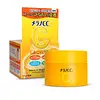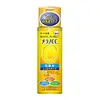What's inside
What's inside
 Key Ingredients
Key Ingredients

 Benefits
Benefits

 Concerns
Concerns

 Ingredients Side-by-side
Ingredients Side-by-side

Ascorbyl Glucoside
AntioxidantTocopheryl Acetate
AntioxidantDipotassium Glycyrrhizate
HumectantAscorbic Acid
AntioxidantAlpinia Katsumadai Seed Extract
Skin ConditioningCitrus Limon Fruit Extract
MaskingCornus Officinalis Fruit Extract
Skin ConditioningC4-18 Alkyl Methacrylate/Methacryloyloxyethyl Phosphorylcholine Copolymer
HumectantButylene Glycol
HumectantPentylene Glycol
Skin ConditioningGlycerin
HumectantBifida Polysaccharide
HumectantPentaerythrityl Tetraethylhexanoate
EmollientPPG-17 Butyl Ether
Skin ConditioningPotassium Hydroxide
BufferingPolyvinylalcohol Crosspolymer
Diethoxyethyl Succinate
SolventPEG-8 Dimethicone
EmulsifyingPolyglyceryl-2 Hydroxypropyl Ethylhexyl Ether
CleansingPolyacrylamide
Phenoxyethanol
PreservativeGlyceryl Hydroxystearate
EmollientParaffinum Liquidum
EmollientPEG-20 Sorbitan Isostearate
EmulsifyingSodium Paraben
PreservativeBehenyl Alcohol
EmollientCetearyl Alcohol
EmollientPPG-4 Lauryl Ether
EmollientXanthan Gum
EmulsifyingC16-24 Alkyl C16-24 Acidate
Skin ConditioningAcrylates/C5-8 Alkyl Acrylate Copolymer
Emulsion StabilisingParfum
MaskingAscorbyl Glucoside, Tocopheryl Acetate, Dipotassium Glycyrrhizate, Ascorbic Acid, Alpinia Katsumadai Seed Extract, Citrus Limon Fruit Extract, Cornus Officinalis Fruit Extract, C4-18 Alkyl Methacrylate/Methacryloyloxyethyl Phosphorylcholine Copolymer, Butylene Glycol, Pentylene Glycol, Glycerin, Bifida Polysaccharide, Pentaerythrityl Tetraethylhexanoate, PPG-17 Butyl Ether, Potassium Hydroxide, Polyvinylalcohol Crosspolymer, Diethoxyethyl Succinate, PEG-8 Dimethicone, Polyglyceryl-2 Hydroxypropyl Ethylhexyl Ether, Polyacrylamide, Phenoxyethanol, Glyceryl Hydroxystearate, Paraffinum Liquidum, PEG-20 Sorbitan Isostearate, Sodium Paraben, Behenyl Alcohol, Cetearyl Alcohol, PPG-4 Lauryl Ether, Xanthan Gum, C16-24 Alkyl C16-24 Acidate, Acrylates/C5-8 Alkyl Acrylate Copolymer, Parfum
3-O-Ethyl Ascorbic Acid
Skin ConditioningDipotassium Glycyrrhizate
HumectantHydrolyzed Grape Fruit Extract
HumectantCitrus Limon Fruit Extract
MaskingAlpinia Katsumadai Seed Extract
Skin Conditioning3-O-Ethyl Ascorbic Acid, Dipotassium Glycyrrhizate, Hydrolyzed Grape Fruit Extract, Citrus Limon Fruit Extract, Alpinia Katsumadai Seed Extract, Butylene Glycol, Glycerin, Dipropylene Glycol, Polyglyceryl-3 Decyltetradecyl Ether, Sodium Paraben, Sodium Citrate, Citric Acid, Xanthan Gum, EDTA, Parfum
 Reviews
Reviews

Alternatives
Ingredients Explained
These ingredients are found in both products.
Ingredients higher up in an ingredient list are typically present in a larger amount.
We don't have a description for Alpinia Katsumadai Seed Extract yet.
Butylene Glycol (or BG) is used within cosmetic products for a few different reasons:
Overall, Butylene Glycol is a safe and well-rounded ingredient that works well with other ingredients.
Though this ingredient works well with most skin types, some people with sensitive skin may experience a reaction such as allergic rashes, closed comedones, or itchiness.
Learn more about Butylene GlycolCitrus Limon Fruit Extract comes from lemons. While lemon extract is exfoliating and antimicrobial, it can also cause skin sensitivity.
Lemons contains antioxidants, which may help with anti-aging. They are also rich in citric acid, an AHA.
And of course, lemons are rich in Vitamin C. Vitamin C helps with skin-brightening and increasing collagen production.
The acidity of lemons may work as an astringent for acne.
However, lemons can also cause skin sensitivity due to its limonene content. It can also increase photosensitivity, or sensitivity to the sun.
This ingredient is also used to add a lemon scent to products.
Learn more about Citrus Limon Fruit ExtractDipotassium Glycyrrhizate comes from licorice root.
Extracts of licorice have demonstrated to have antibacterial, anti‐inflammatory, antiviral, antioxidant properties.
One component, glabridin, has extra potent antioxidant and soothing properties. It has also been found to block pigmentation from UVB rays in guinea pigs.
Licorice Root also contains a flavonoid. Flavonoids are a natural substance from in plants. Flavonoids also have antioxidant properties.
Another component, glycyrrhizin, has been found to have anti-inflammatory and antimicrobial benefits. This may make licorice root extract effective at treating acne. However, more research is needed to support this.
Liquiritin is one of the flavone compounds found in licorice. It has been found to help lighten skin by preventing tyrosinase from reacting with tyrosine. When the two react, protein is converted to melanin. Melanin is the substance in your body that gives your features pigmentation.
Licorice root is native to Southern Europe and Asia. It has been used in traditional Chinese medicine to help with respiratory issues.
Learn more about Dipotassium GlycyrrhizateGlycerin is already naturally found in your skin. It helps moisturize and protect your skin.
A study from 2016 found glycerin to be more effective as a humectant than AHAs and hyaluronic acid.
As a humectant, it helps the skin stay hydrated by pulling moisture to your skin. The low molecular weight of glycerin allows it to pull moisture into the deeper layers of your skin.
Hydrated skin improves your skin barrier; Your skin barrier helps protect against irritants and bacteria.
Glycerin has also been found to have antimicrobial and antiviral properties. Due to these properties, glycerin is often used in wound and burn treatments.
In cosmetics, glycerin is usually derived from plants such as soybean or palm. However, it can also be sourced from animals, such as tallow or animal fat.
This ingredient is organic, colorless, odorless, and non-toxic.
Glycerin is the name for this ingredient in American English. British English uses Glycerol/Glycerine.
Learn more about GlycerinParfum is a catch-all term for an ingredient or more that is used to give a scent to products.
Also called "fragrance", this ingredient can be a blend of hundreds of chemicals or plant oils. This means every product with "fragrance" or "parfum" in the ingredients list is a different mixture.
For instance, Habanolide is a proprietary trade name for a specific aroma chemical. When used as a fragrance ingredient in cosmetics, most aroma chemicals fall under the broad labeling category of “FRAGRANCE” or “PARFUM” according to EU and US regulations.
The term 'parfum' or 'fragrance' is not regulated in many countries. In many cases, it is up to the brand to define this term.
For instance, many brands choose to label themselves as "fragrance-free" because they are not using synthetic fragrances. However, their products may still contain ingredients such as essential oils that are considered a fragrance by INCI standards.
One example is Calendula flower extract. Calendula is an essential oil that still imparts a scent or 'fragrance'.
Depending on the blend, the ingredients in the mixture can cause allergies and sensitivities on the skin. Some ingredients that are known EU allergens include linalool and citronellol.
Parfum can also be used to mask or cover an unpleasant scent.
The bottom line is: not all fragrances/parfum/ingredients are created equally. If you are worried about fragrances, we recommend taking a closer look at an ingredient. And of course, we always recommend speaking with a professional.
Learn more about ParfumSodium Paraben is a preservative and is a paraben.
Xanthan gum is used as a stabilizer and thickener within cosmetic products. It helps give products a sticky, thick feeling - preventing them from being too runny.
On the technical side of things, xanthan gum is a polysaccharide - a combination consisting of multiple sugar molecules bonded together.
Xanthan gum is a pretty common and great ingredient. It is a natural, non-toxic, non-irritating ingredient that is also commonly used in food products.
Learn more about Xanthan Gum